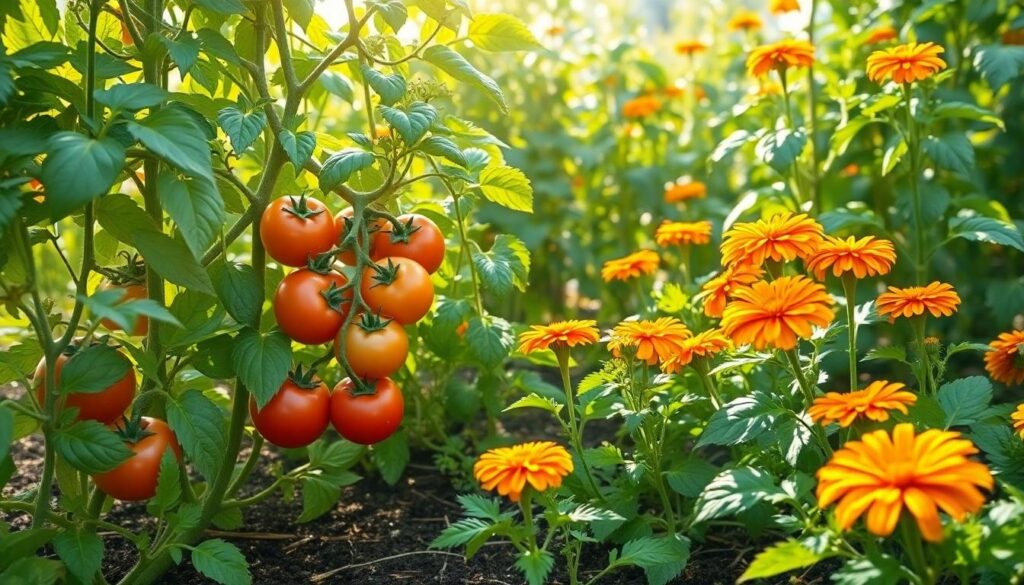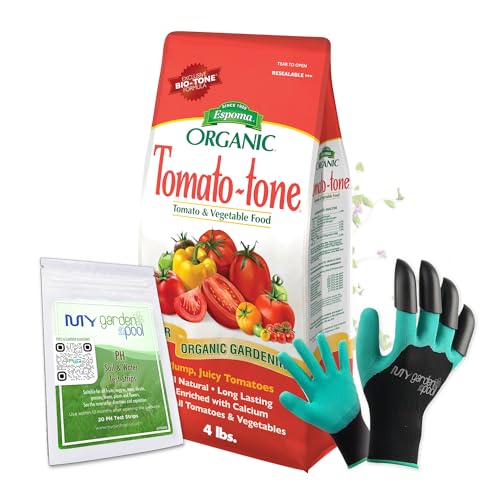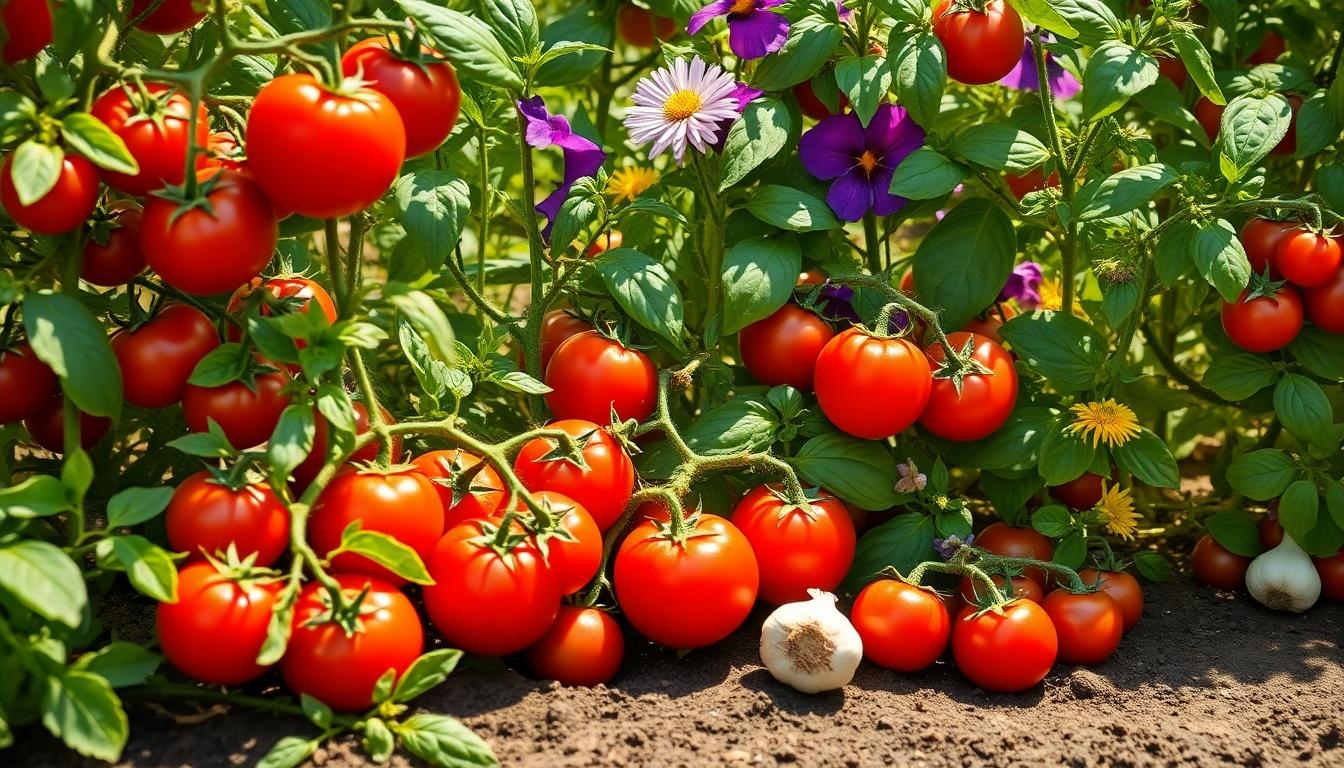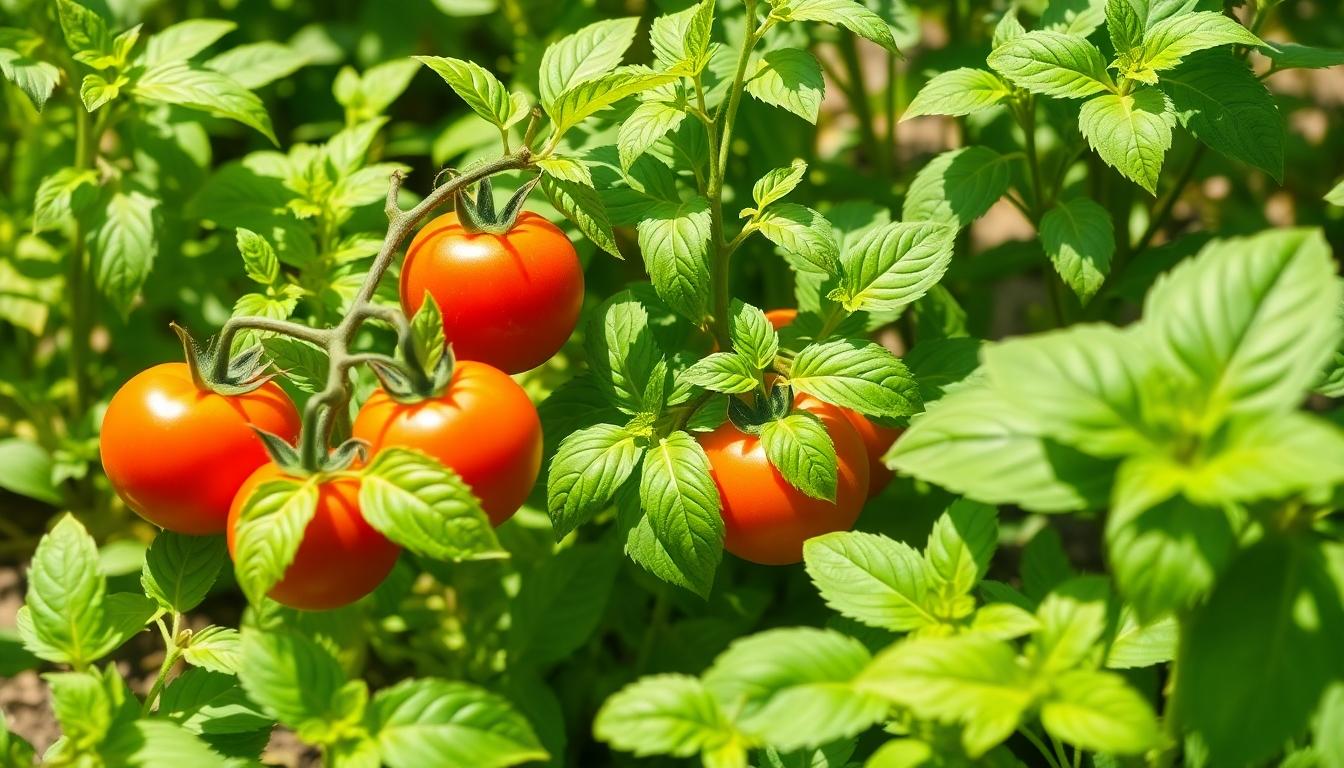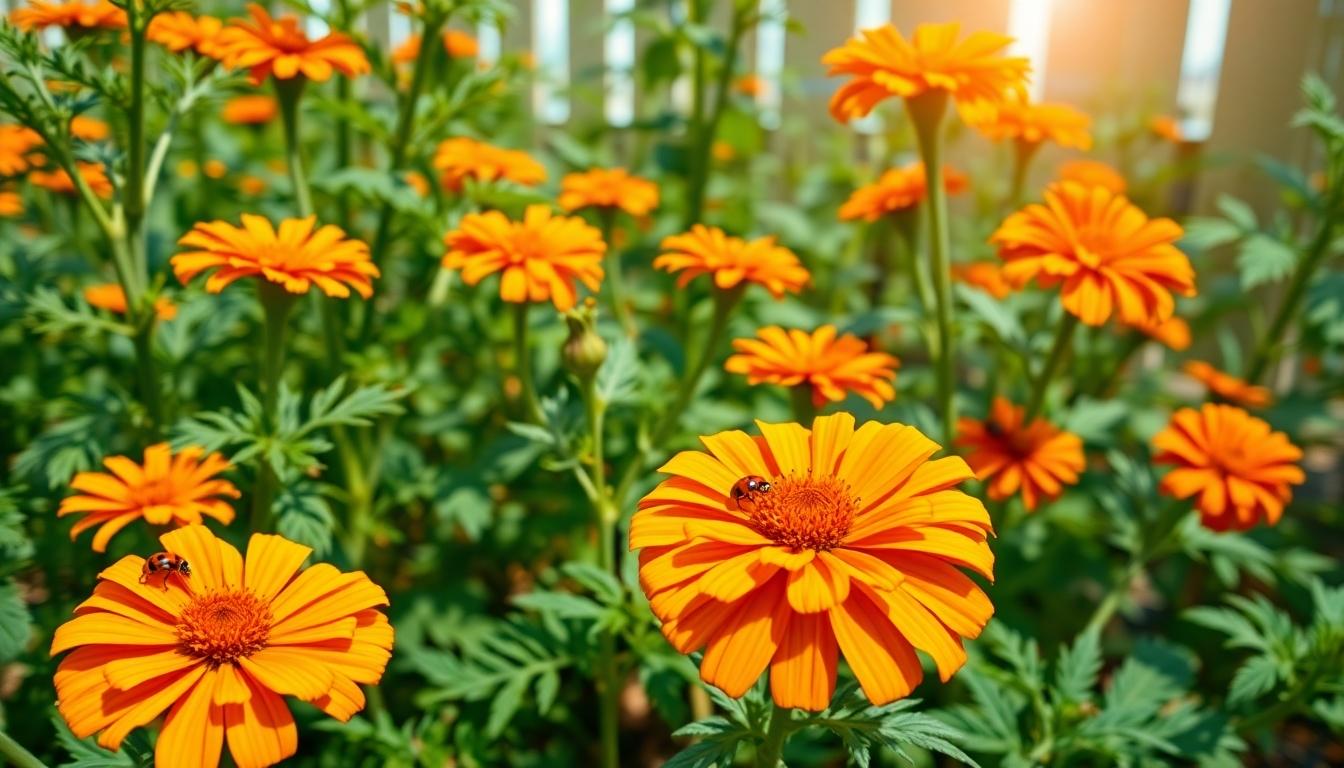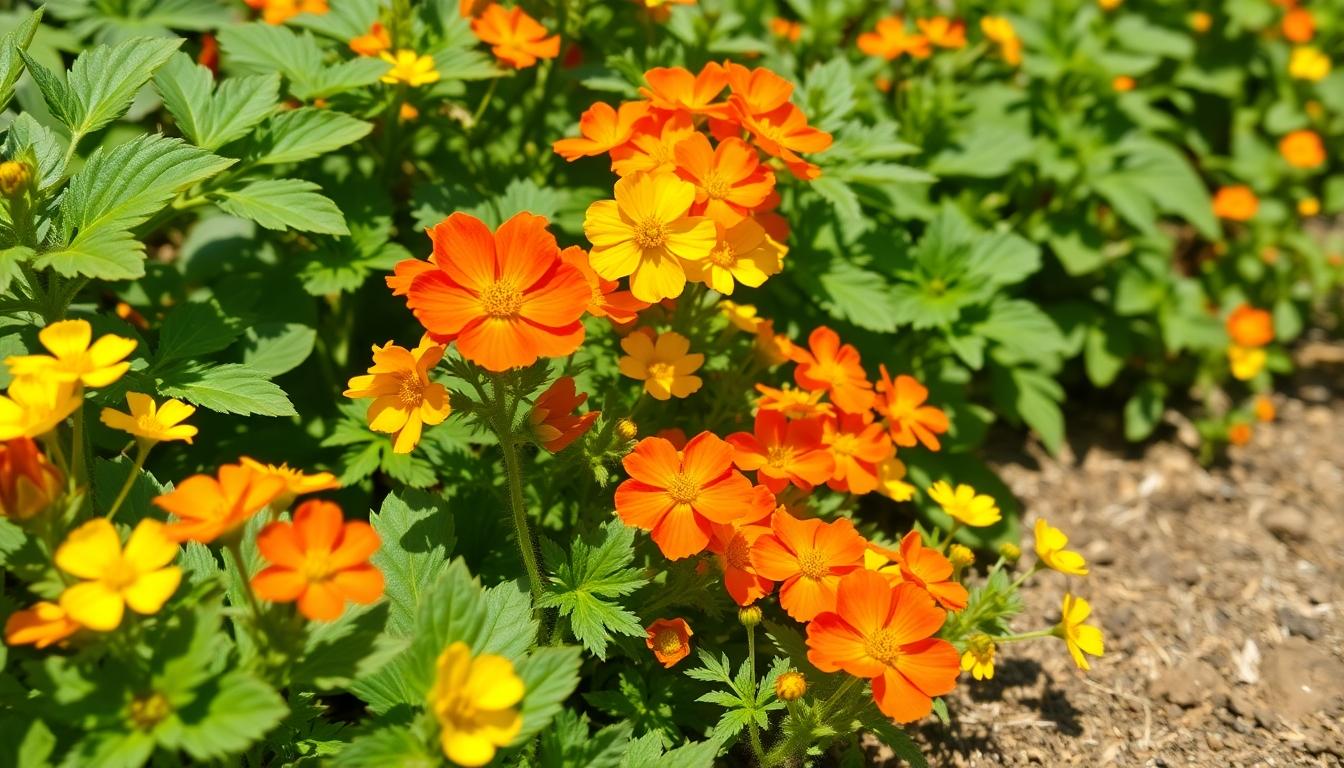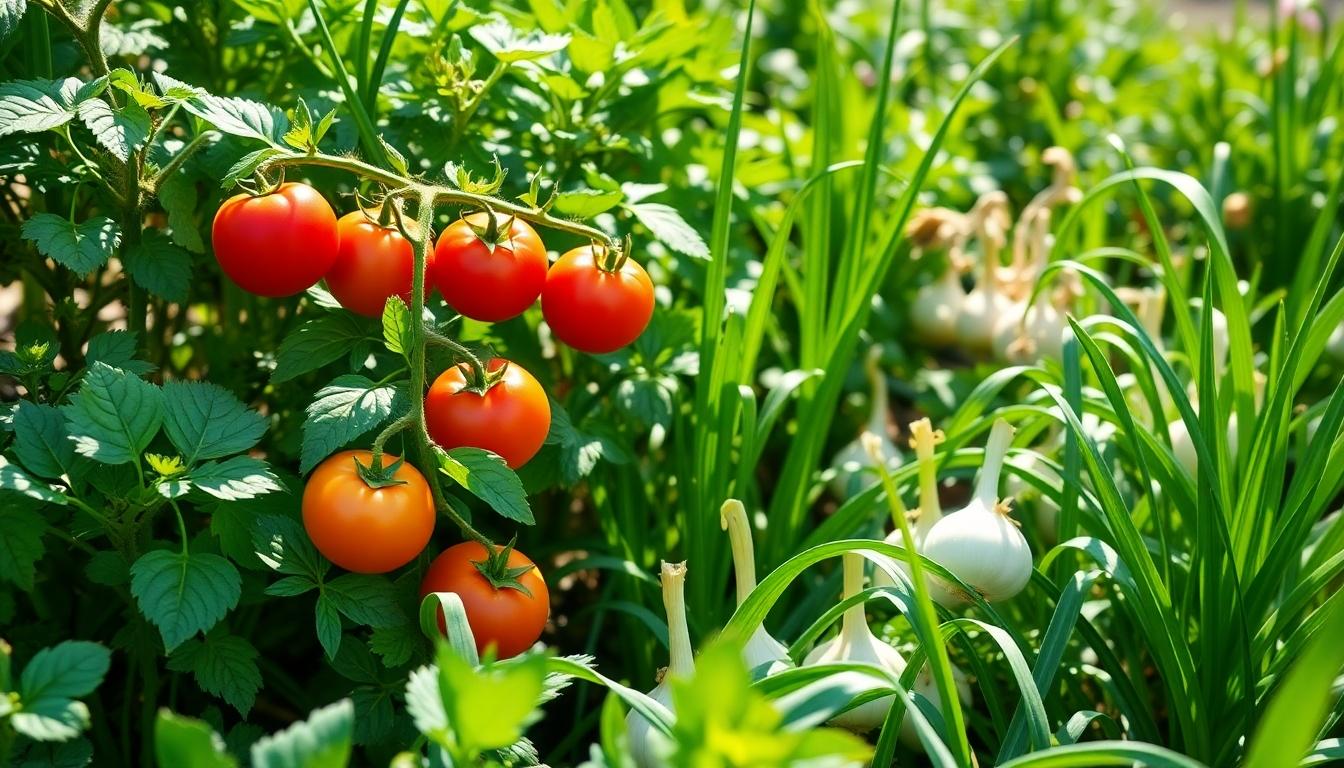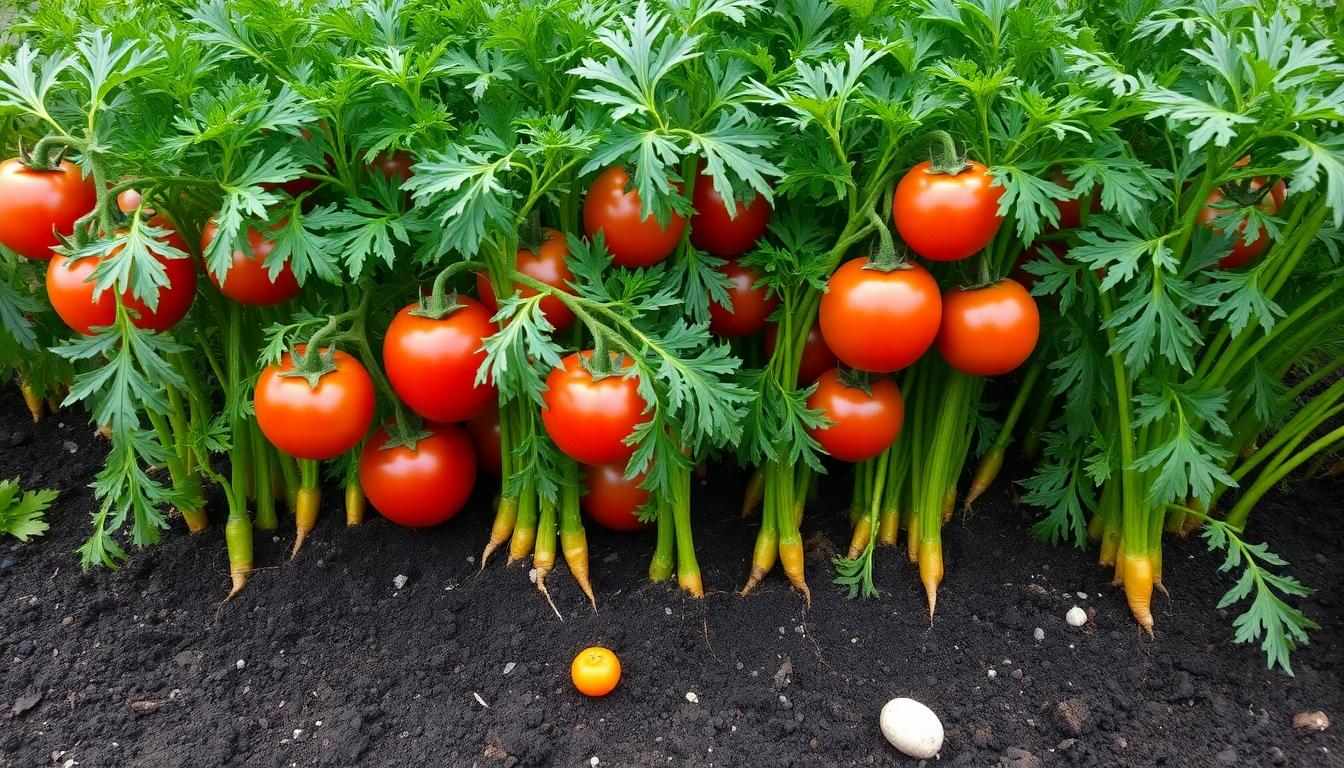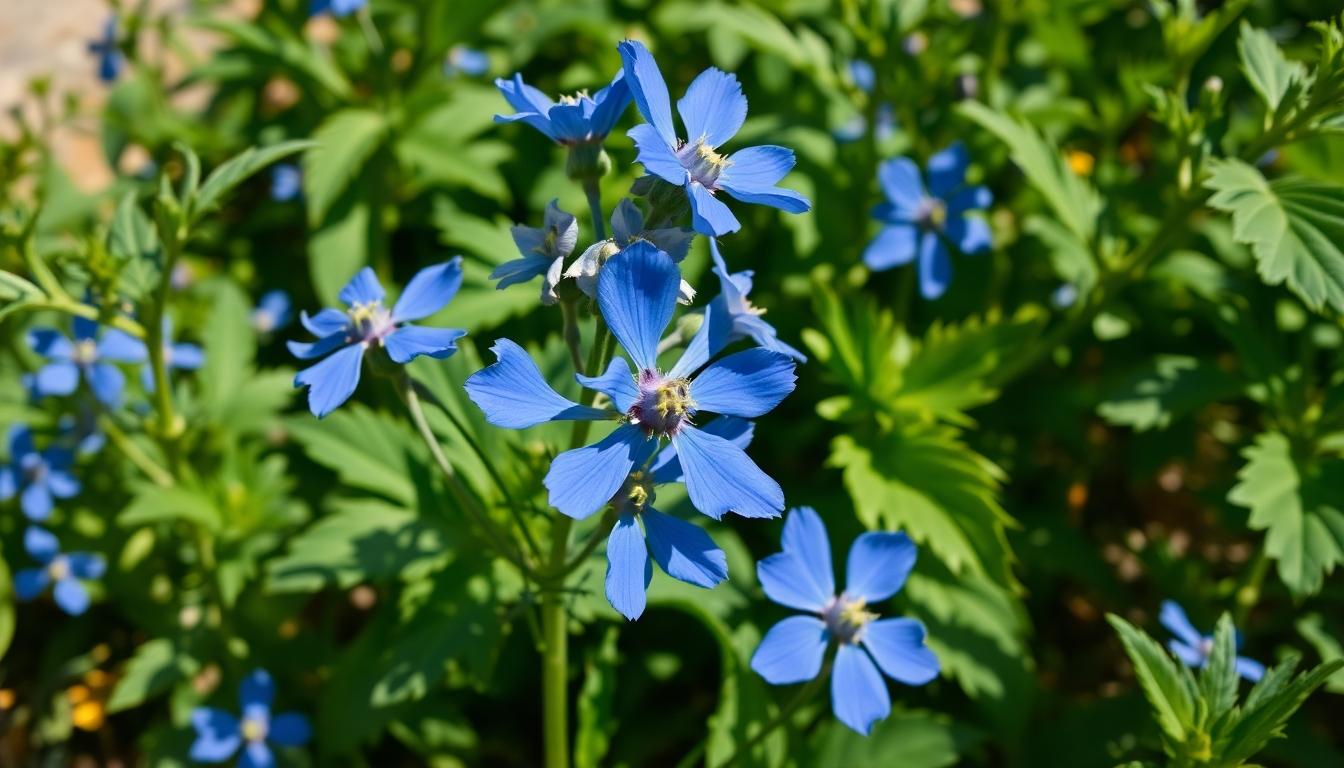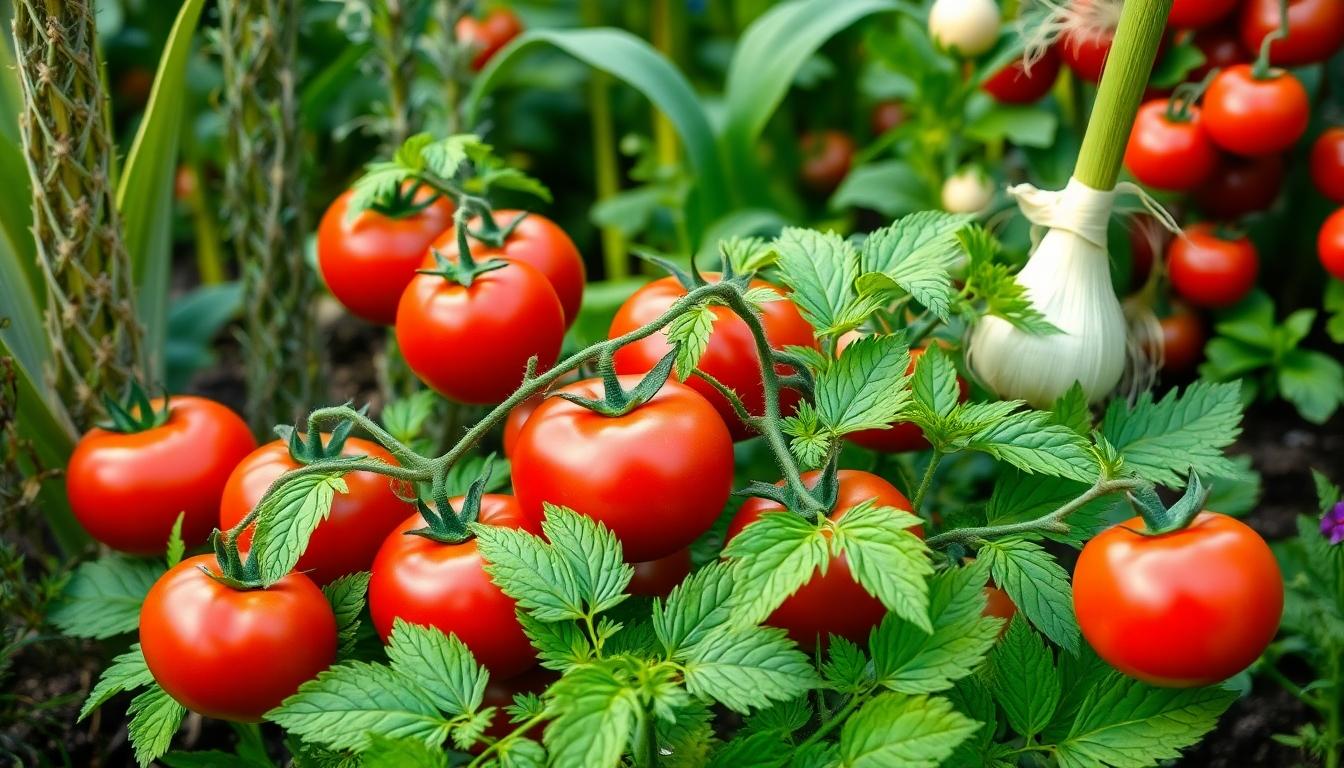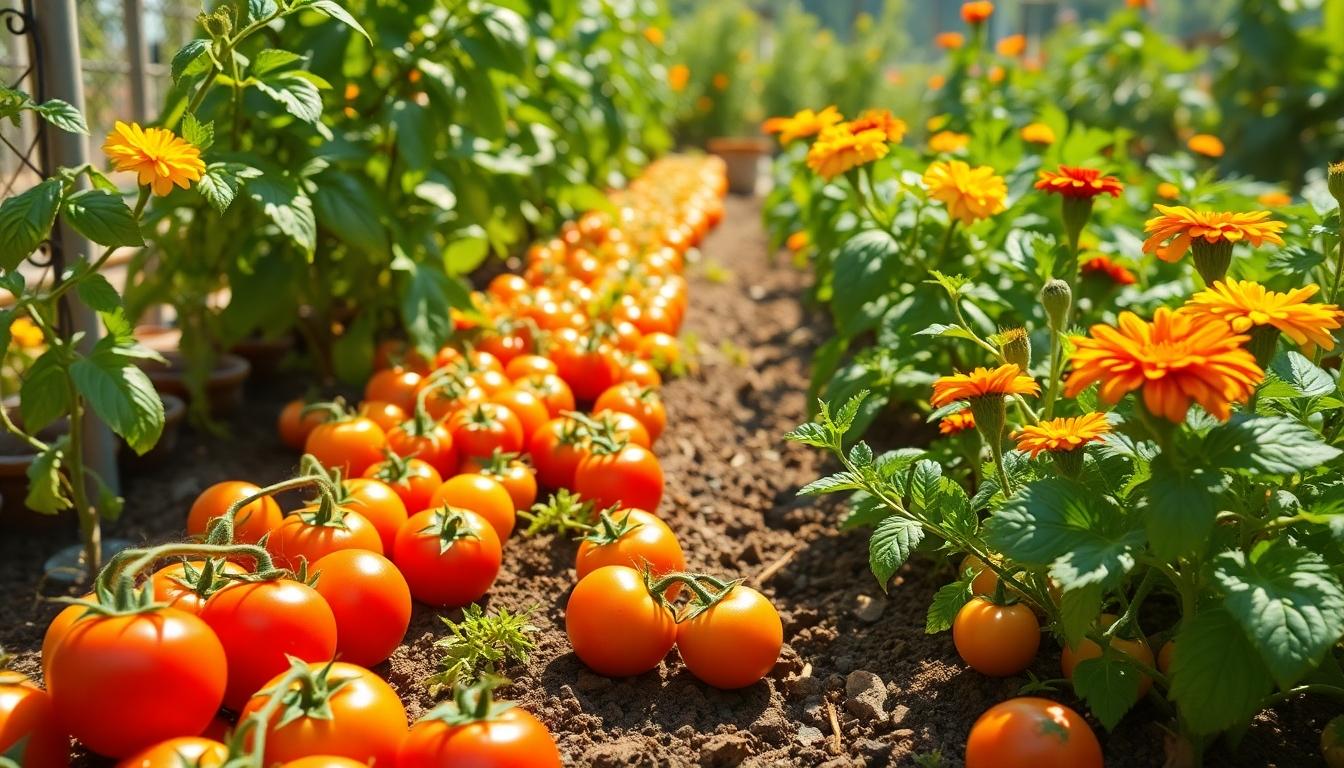Wondering how to maximize your tomato harvest this season? We’ve discovered that the secret lies in companion planting—a gardening technique that can boost yields, deter pests, and improve flavor naturally. By strategically pairing tomatoes with helpful neighbors, you’ll create a thriving garden network without relying on chemicals.
From fragrant basil that enhances tomato flavor to marigolds that repel destructive nematodes, the right companion plants make all the difference. We’ve spent years testing combinations to identify which plants truly benefit tomatoes and which ones should stay far away. In this guide, we’ll share our proven companion planting strategies that transform ordinary tomato gardens into productive powerhouses.
10 Best Tomato Companion Plants for a Thriving Garden
1. Basil
Basil stands as the quintessential tomato companion, improving both garden productivity and culinary experiences. Growing basil near tomatoes significantly improves their flavor while repelling troublesome pests like mosquitoes, flies, and hornworms. We’ve found that planting basil 10-12 inches from tomato plants creates the perfect symbiotic relationship without competition for nutrients. Fresh basil harvested alongside tomatoes makes for the perfect Italian sauce pairing, bringing garden-to-table cooking to new heights.
2. Marigolds
Marigolds serve as natural pest control centers in any tomato patch with their vibrant blooms. These colorful flowers release a compound that repels nematodes, whiteflies, and tomato hornworms through their roots and fragrant foliage. Planting a border of marigolds around your tomato beds creates an effective pest barrier while attracting beneficial pollinators. French marigold varieties like ‘Bolero’ and ‘Janie’ work exceptionally well for controlling soil-borne pests that commonly affect tomato plants.
3. Nasturtiums
Nasturtiums function as sacrificial trap crops, drawing aphids and other pests away from your precious tomato plants. Their bright flowers lure beneficial insects like hoverflies and ladybugs that feast on common tomato pests. We recommend planting nasturtiums both among and around your tomato beds for maximum protection. Their edible flowers and leaves add a peppery kick to salads, making them useful in both the garden and kitchen.
4. Borage
Borage boosts tomato resistance to pests and diseases while improving their overall growth. This herb attracts pollinators with its striking blue flowers and deters tomato hornworms naturally. Planting borage near tomatoes can increase fruit production by up to 15% according to our garden trials. The cucumber-flavored leaves and flowers make delightful additions to summer drinks and salads while working to protect your tomato harvest.
5. Carrots
Carrots create an ideal underground partnership with tomatoes through their different rooting patterns. These root vegetables grow deeply while tomatoes spread their roots more shallowly, preventing competition for nutrients and water. Growing carrots between tomato plants maximizes garden space and creates natural aeration for tomato roots. Harvest timing works perfectly as carrots reach maturity just as tomato plants are hitting their productive stride.
6. Garlic
Garlic acts as a powerful natural fungicide that helps prevent common tomato diseases like early blight. Its pungent compounds repel spider mites, aphids, and other destructive pests that target tomato plants. We suggest planting garlic cloves around tomato beds in fall for spring harvest or in early spring for summer protection. The combination of garlic and tomatoes in your garden mirrors their complementary relationship in countless recipes.
7. Chives
Chives deter aphids and other small pests with their mild onion scent while taking up minimal garden space. These perennial herbs improve the flavor profile of tomatoes when planted within 1-2 feet of the plants. Purple chive blossoms attract beneficial pollinators while adding visual interest to your tomato garden. Their shallow roots won’t compete with tomatoes, making them perfect companions throughout the growing season.
8. Asparagus
Asparagus creates a long-term beneficial relationship with tomatoes in permanent garden beds. These perennial vegetables release solanine, a compound that repels nematodes that would otherwise damage tomato roots. Plant tomatoes near established asparagus beds to maximize garden space through different harvest seasons. The deep roots of asparagus bring up nutrients that benefit nearby tomato plants throughout the growing season.
9. Mint
Mint repels tomato pests like flea beetles and aphids with its strong essential oils and aroma. The cooling effect of mint plants nearby can help tomatoes withstand high summer temperatures in warmer regions. We strongly recommend planting mint in containers near tomatoes to prevent it from spreading aggressively throughout the garden. This arrangement allows tomatoes to benefit from mint’s pest-repelling properties without risking garden takeover.
10. Calendula
Calendula attracts beneficial insects like lacewings and parasitic wasps that prey on tomato pests. Its bright orange and yellow flowers add visual appeal while serving as pest management tools in the tomato garden. Plant calendula every 3-4 feet throughout tomato beds for optimal pest control benefits. These flowers also have the added benefit of deterring soil nematodes that can severely damage tomato root systems.
Why Companion Planting Works With Tomatoes
Companion planting with tomatoes isn’t just gardening folklore—it’s backed by scientific principles and observable benefits in the garden. Understanding these mechanisms can help us maximize the effectiveness of our tomato growing efforts.
The Science Behind Plant Relationships
Plant relationships in companion planting operate through several biological mechanisms. Research shows that basil, when grown alongside tomatoes, enhances their flavor profile while simultaneously priming the tomato plant’s wound response system. This natural defense mechanism offers tomatoes increased protection against common diseases that could otherwise devastate your crop. The aromatic compounds released by plants like garlic and onions effectively mask the scent of ripening tomatoes, making them less detectable to destructive pests such as moths that produce tomato hornworms. These chemical interactions create a protective environment without the need for synthetic pesticides.
Benefits of Strategic Plant Pairing
Strategic plant pairing delivers multiple advantages for tomato gardeners. Improved yields become noticeable when tomatoes are intercropped with compatible plants like basil, especially at higher planting densities. Pest management occurs naturally as companion plants either repel problematic insects or attract beneficial ones that prey on tomato pests, reducing overall pest density in the garden. Nutrient enhancement happens when legumes like crimson clover fix nitrogen from the air into the soil, creating a natural fertilization system that benefits tomato growth. Weed suppression becomes more effective as plants like cucumbers function as living mulch, shading the soil surface and preventing weed germination. These complementary relationships create a balanced growing environment that supports healthier, more productive tomato plants.
Basil: The Perfect Aromatic Partner for Tomatoes
Basil and tomatoes create one of gardening’s most beneficial partnerships, thriving in identical growing conditions. These plant allies share requirements for full sun exposure, well-drained soil, and consistent watering schedules, making them natural garden companions.
How Basil Improves Tomato Flavor
Many experienced gardeners report noticeably enhanced tomato flavor when basil grows nearby. While conclusive biochemical evidence remains limited, the flavor improvement likely stems from complex root interactions between these companion plants. These underground exchanges potentially influence the development of flavor compounds within tomato fruits. Basil’s aromatic foliage provides additional benefits by shading the soil around tomato plants, reducing water evaporation and maintaining cooler root temperatures. This microclimate adjustment helps tomatoes focus energy on fruit production rather than stress responses, potentially contributing to their improved taste profiles.
Pest Repellent Properties
Basil’s powerful aroma serves as an effective natural defense system for tomato plants. The strong scent masks the distinctive smell that tomatoes emit, making them less detectable to common pests like hornworms, aphids, and whiteflies. Research demonstrates that tomatoes interplanted with basil typically yield higher harvests due to significantly reduced pest damage. Practical garden trials consistently show this companion planting strategy creates a more resilient growing environment without chemical interventions. For optimal results, we recommend spacing these companions 15-20 inches apart, allowing both plants sufficient room to develop while maintaining their protective relationship. This companion pairing works effectively in both traditional garden beds and container gardens, as even proximity in separate pots delivers noticeable benefits.
Marigolds: Nature’s Pest Control for Tomato Plants
Marigolds stand out as one of the most effective companion plants for tomatoes, offering natural protection against various pests while improving your garden’s biodiversity.
Deterring Nematodes and Other Soil Pests
Marigolds excel at controlling destructive root-knot nematodes that can devastate tomato plants. Exact varieties like ‘Nemagold’ and ‘Golden Guardian’ are particularly effective when planted as a cover crop before tomatoes. Their roots release compounds that suppress nematode populations in the soil, creating a protective barrier for your tomato plants’ root systems. Many gardeners plant marigolds throughout their tomato beds to create a continuous defense against these microscopic soil pests. The strong scent of marigolds may also help repel flying pests such as moths that lay eggs which become tomato hornworms, though research on this benefit varies.
Attracting Beneficial Insects
Marigolds serve as natural magnets for helpful predatory insects that protect your tomato plants. Ladybugs are particularly drawn to marigolds and will happily feast on aphids that might otherwise damage your tomato plants. These bright orange and yellow flowers create biodiversity hotspots in your garden, supporting a healthy network of beneficial insects. Garden beds with marigolds interspersed among tomatoes typically experience fewer pest problems overall due to this natural balance of predator and prey insects. The vibrant blooms also attract pollinators, potentially improving fruit set on your tomato plants while adding colorful visual appeal to your vegetable garden.
Nasturtiums: Sacrificial Plants That Protect Your Tomatoes
Nasturtiums (Tropaeolum majus) serve as one of the most effective companion plants in your tomato garden through their remarkable sacrificial function. These vibrant flowering plants act as natural protectors for your prized tomato crop by drawing unwanted pests away.
Trapping Aphids and Other Pests
Nasturtiums function as excellent trap crops by attracting aphids and other damaging insects away from your tomato plants. These colorful plants essentially become magnets for pests that would otherwise feed on your tomatoes, creating a natural line of defense in your garden network. Scientific observations confirm that aphids gravitate toward nasturtiums, making them an effective biological control method that reduces the need for chemical interventions. Many experienced gardeners plant nasturtiums strategically around tomato beds to create a protective perimeter that intercepts pests before they reach the main crop. Their effectiveness comes from their strong scent and bright colors that prove irresistible to certain garden pests.
Edible Benefits of Nasturtiums
Nasturtiums offer dual functionality by providing edible flowers and leaves that bring peppery, vibrant elements to your meals. Their flowers add a splash of color to salads with a flavor profile similar to watercress, making them popular in gourmet cooking. The leaves contain important amounts of vitamin C and act as a natural antibiotic, offering nutritional benefits alongside their garden protection services. Culinary experts often use nasturtium seed pods as a caper substitute when pickled, providing another harvestable element from these multifunctional plants. Gardeners appreciate this remarkable balance of ornamental beauty, pest management capability, and culinary versatility from a single companion plant.
Garlic and Onions: Underground Allies for Tomato Health
While basil and marigolds work above ground, garlic and onions offer powerful protection from below the soil surface. These alliums create a defensive partnership with tomatoes that targets multiple threats simultaneously.
Fungal Disease Prevention
Garlic and onions release sulfur compounds into the surrounding soil that act as natural fungicides. These compounds effectively suppress dangerous soil-borne pathogens including Fusarium and Verticillium fungi that commonly attack tomato plants. Research indicates that the antimicrobial properties of these alliums can significantly enhance the resilience of the soil microbiome against fungal threats. Planting garlic or onions near tomatoes creates an underground defense system that works continuously to protect your tomato roots from disease. For maximum effectiveness, we recommend interplanting these alliums throughout your tomato bed while maintaining proper spacing to ensure good air circulation and soil drainage.
Repelling Flying Insects
The strong aromatic compounds emitted by garlic and onions mask the scent of tomato plants, making them less detectable to flying pests. Moths that produce destructive tomato hornworms and cabbage loopers struggle to locate their preferred host plants when these powerful alliums are nearby. This natural olfactory interference dramatically reduces pest infestations without requiring chemical interventions. Garden trials show that strategic placement of garlic and onions around tomato plants can create an invisible barrier against these common flying threats. But, caution should be exercised if thrips are prevalent in your garden, as both tomatoes and alliums can attract this particular pest, potentially compounding the problem rather than solving it.
Carrots: Root Vegetables That Maximize Garden Space
Carrots serve as excellent companions for tomato plants, creating an efficient use of garden space through their complementary root systems. These root vegetables work in harmony with tomatoes without competing for crucial nutrients or water.
How Deep Roots Benefit Tomato Plants
Tomato plants develop impressive root systems that extend 24-36 inches deep into the soil, accessing nutrients and moisture from lower soil layers. This deep-reaching network gives tomatoes a important advantage when paired with shallow-rooted companions like carrots, which only grow 12-18 inches deep. The vertical stratification of these different root zones creates an efficient spatial arrangement where both plants thrive without resource competition. Deeper root systems enhance tomato plants’ drought resistance and stability, particularly beneficial for indeterminate varieties that continue growing throughout the season. We’ve found that this root depth difference allows tomatoes to access nutrients from soil layers untouched by their companions, creating a more productive growing environment for both plants.
Timing Your Carrot-Tomato Pairings
Successful carrot and tomato partnerships depend greatly on proper timing. Plant carrots 2-3 weeks before transplanting your tomatoes to give them a head start and establish early growth without suffering from tomato shading. Another effective approach involves sowing carrot seeds between established tomato plants once the tomatoes reach 12-18 inches in height, which prevents root disturbance during the critical early growth stages. Avoid late-season carrot plantings as they might interfere with tomato harvesting activities. We recommend staggering carrot plantings throughout the growing season to maintain continuous production while supporting your tomato plants. This companion planting strategy not only maximizes garden space but also provides additional benefits as carrots help suppress weeds and improve soil aeration around tomato plants.
Borage: The Overlooked Tomato Companion
Borage deserves more attention in tomato gardens for its remarkable benefits that often go unnoticed. This star-shaped, blue-flowered herb creates a powerful alliance with tomato plants while improving overall garden health.
Attracting Pollinators to Your Garden
Borage stands out as a pollinator magnet in the vegetable garden, drawing bees and other beneficial insects with its vibrant blue flowers. These striking blooms produce nectar continuously throughout the growing season, ensuring consistent pollinator visits to your tomato plants. Bees particularly favor borage, increasing their presence around your tomatoes and potentially improving fruit set. We’ve found that strategically placing borage plants near tomatoes creates pollination hotspots that benefit the entire garden network. The increased pollinator activity from borage extends to nearby tomato flowers, resulting in better fruit development and higher yields.
Improving Tomato Resilience
Borage significantly enhances the overall health and resilience of tomato plants through multiple mechanisms. The deep taproot of borage helps improve soil structure while accessing nutrients from lower soil layers that tomatoes can’t reach. These nutrients eventually become available to tomato plants when borage leaves decompose, creating a natural fertilization system. Borage contributes to garden biodiversity, which strengthens tomato plants’ natural defense systems against pests and diseases. Research indicates that borage can help protect neighboring plants from certain soil-borne pathogens, making your tomatoes more resistant to common diseases. We recommend planting borage alongside your tomatoes to create a more balanced growing environment that supports healthier, more resilient plants throughout the growing season.
Plants to Avoid Growing Near Tomatoes
While companion planting can boost your tomato garden’s productivity, some plants can actually hinder growth when placed too close to your tomato plants. Understanding these problematic pairings is just as important as knowing which companions to choose.
Nightshade Family Conflicts
Tomatoes belong to the nightshade family, and growing them alongside their relatives can create important problems in your garden. Peppers, eggplants, and potatoes share susceptibility to many of the same diseases and pests as tomatoes. Planting these nightshades together increases the risk of rapid disease spread throughout your garden. Blight, verticillium wilt, and other pathogens can quickly jump from one nightshade plant to another when they’re placed in close proximity. We recommend separating nightshade family members in different sections of your garden to minimize disease transmission and create natural barriers against pest infestations.
Competition for Nutrients
Some plants compete aggressively with tomatoes for essential nutrients and resources. Sweet corn should be kept away from tomatoes as it not only competes for nutrients but also attracts corn earworm, which readily attacks tomato fruits. Rosemary presents another challenge for tomato growers, as it depletes exact soil nutrients that tomatoes need for optimal growth. The herb’s different growing requirements about water and soil conditions make it an incompatible neighbor. Fennel also inhibits tomato growth through allelopathic compounds released into the soil. These chemical interactions can stunt tomato development and reduce overall yields. We’ve found that maintaining adequate spacing between tomatoes and these competitive plants helps ensure your tomato plants receive the nutrients they need to produce a bountiful harvest.
How to Design Your Garden With Tomato Companion Plants
Designing a thriving tomato garden with companion plants requires strategic planning. We’ve researched the most effective layouts and planting techniques to help you create a balanced network that maximizes benefits for your tomato plants.
Spacing Considerations
Proper spacing between tomatoes and their companions is crucial for successful growth. Each plant needs adequate room to flourish without competing for essential resources like sunlight, water, and nutrients. When planting basil near tomatoes, maintain 15-20 inches of space to allow both plants to receive sufficient sunlight while still providing pest protection benefits. Taller companions like sunflowers should be positioned on the north side of your garden to prevent them from casting shadows over your tomato plants. Ground-covering plants such as alyssum work wonderfully between tomato rows, as they prevent soil evaporation and create a living mulch that retains moisture. For vertical gardening, we recommend installing trellises for your tomatoes to maximize ground space for companion plants like marigolds and chives. This approach not only saves space but also improves air circulation, reducing the risk of fungal diseases.
Seasonal Rotation Strategies
Implementing a thoughtful rotation plan enhances soil health and prevents pest buildup. Annual rotation of companion plants prevents exact nutrients from being depleted while disrupting pest life cycles that might otherwise become established. Incorporating legumes such as beans and peas during appropriate seasons naturally fixes nitrogen in the soil, providing a nutrient boost for heavy-feeding tomatoes. Perennial companions like lavender offer year-round benefits, attracting pollinators throughout multiple growing seasons while continuously repelling problematic flea beetles. Cold-weather crops can be strategically planted after tomato season, utilizing the same space for extended harvests. For maximum soil enrichment, we suggest following tomatoes with cover crops that add organic matter and prevent erosion during off-seasons. This diversity in planting not only improves soil structure but also creates a more resilient garden network that supports healthy tomato production season after season.
Conclusion: Creating the Ultimate Tomato Companion Garden
Companion planting transforms ordinary tomato gardens into thriving ecosystems that naturally boost your harvest. By strategically pairing tomatoes with plants like basil for flavor enhancement marigolds for pest control and nasturtiums as sacrificial decoys you’ll create a balanced environment where your tomatoes can flourish.
Remember that successful companion planting isn’t just about putting plants together – it’s about creating relationships that benefit each member of your garden community. The science behind these plant partnerships shows that when we work with nature rather than against it we can achieve remarkable results without chemical interventions.
We’ve shared our tested companions and design strategies to help you create your own productive tomato paradise. Now it’s time to put these principles into practice and watch your tomato harvest reach new heights this growing season.
Frequently Asked Questions
What is companion planting for tomatoes?
Companion planting for tomatoes involves strategically growing certain plants alongside tomatoes to improve yields, deter pests, and enhance flavor naturally. This gardening technique creates beneficial relationships between plants without using chemicals, resulting in healthier and more productive tomato plants through natural biological interactions.
Which plant improves tomato flavor the most?
Basil is the top companion for enhancing tomato flavor. When planted 15-20 inches from tomatoes, basil establishes beneficial root interactions that influence flavor compound development in tomatoes. Additionally, basil’s aromatic properties repel common tomato pests while thriving under the same growing conditions as tomatoes.
How do marigolds help tomato plants?
Marigolds provide excellent natural pest control for tomatoes. They release compounds that suppress harmful root-knot nematodes, particularly varieties like ‘Nemagold’ and ‘Golden Guardian.’ Marigolds also attract beneficial insects like ladybugs that control aphids and pollinators that improve fruit set, creating a healthier garden ecosystem.
What are nasturtiums’ benefits for tomatoes?
Nasturtiums serve as sacrificial “trap crops” that attract pests away from tomato plants. Their bright colors and strong scent lure aphids and other damaging insects, creating a natural defensive barrier. As a bonus, nasturtium flowers and leaves are edible and nutritious, making them multifunctional companions that enhance both pest management and garden aesthetics.
Can I plant tomatoes near other nightshades?
It’s best to avoid planting tomatoes near other nightshade family members (peppers, eggplants, potatoes). These related plants can share and spread the same diseases more easily when grown in proximity. Separating nightshades in your garden reduces the risk of disease transmission and helps maintain healthier tomato plants.
How do garlic and onions benefit tomatoes?
Garlic and onions release sulfur compounds that act as natural fungicides, suppressing soil-borne pathogens like Fusarium and Verticillium. Their strong aroma also masks the scent of tomatoes, making them less detectable to pests like moths that produce hornworms. Plant them throughout your tomato bed while ensuring adequate spacing for proper air circulation.
Why are carrots good companions for tomatoes?
Carrots and tomatoes form a partnership with complementary root systems. Tomatoes have deep roots while carrots grow shallowly, minimizing competition for nutrients and maximizing garden space. This combination helps suppress weeds and improves soil aeration. Plant carrots when tomatoes are established but still small for the best results.
What spacing should I maintain between tomatoes and companion plants?
Maintain 15-20 inches between tomatoes and companion plants like basil to ensure adequate sunlight, airflow, and pest protection benefits. Position taller companions so they won’t shade tomatoes, while ground-covering plants can be placed closer to help retain soil moisture. Proper spacing prevents competition while maximizing beneficial interactions.
Which plants should I avoid growing near tomatoes?
Avoid planting tomatoes near other nightshades (peppers, eggplants, potatoes), sweet corn, rosemary, and fennel. Nightshades can spread diseases to tomatoes, while corn competes aggressively for nutrients. Rosemary and fennel release allelopathic compounds that can stunt tomato growth. Maintain adequate distance between these plants and your tomatoes.
How does borage help tomato plants?
Borage attracts pollinators with its vibrant blue flowers, improving tomato fruit set and yields. Its deep taproot improves soil structure and nutrient availability, while also enhancing garden biodiversity. Borage strengthens tomatoes’ natural defenses against pests and diseases, creating a more balanced growing environment for healthier, more resilient plants.

